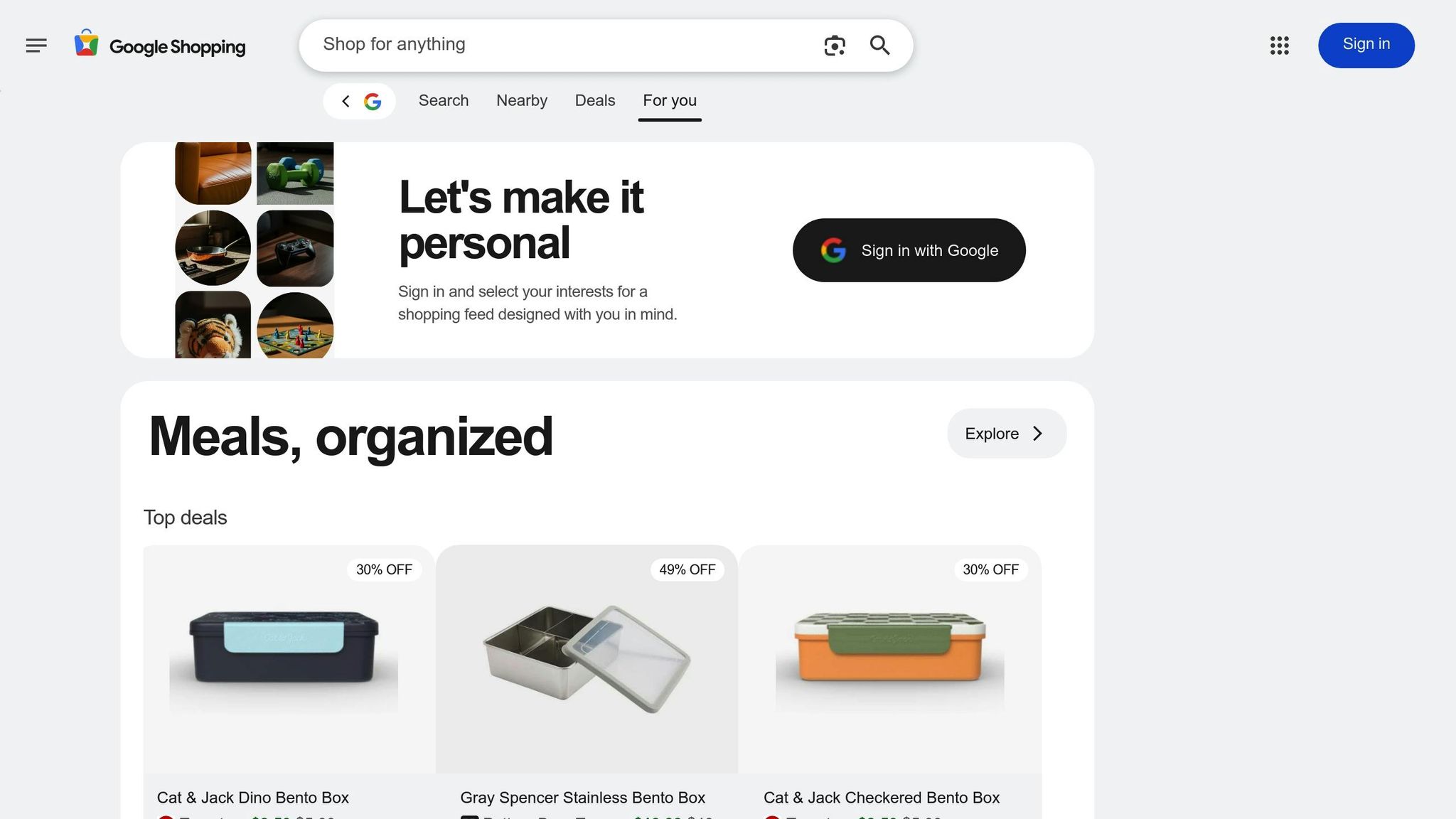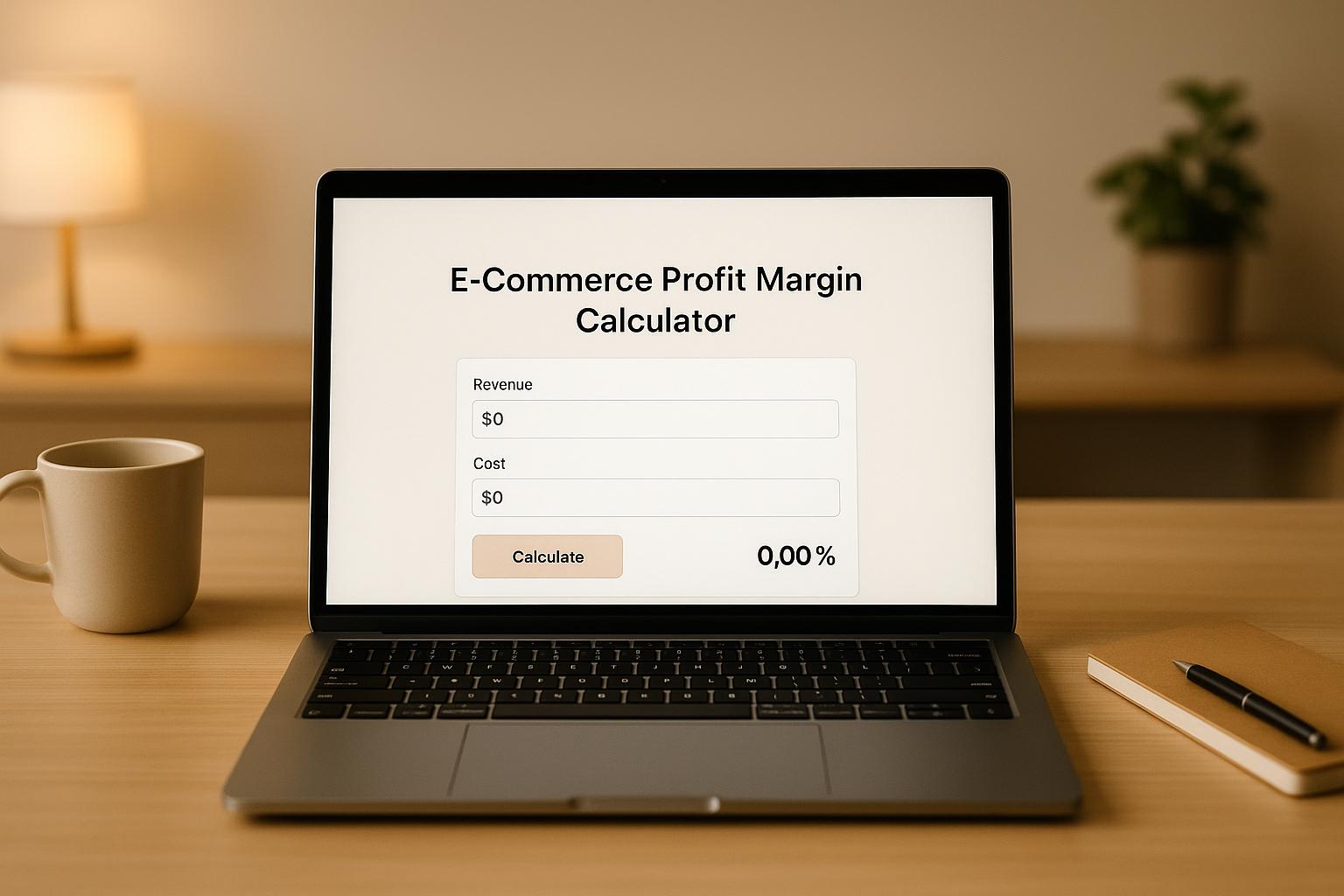AI Attribute Enrichment for Google Shopping Feeds
Want your products to show up more often on Google Shopping? It all comes down to the details.
AI is transforming how merchants manage product feeds by automating the process of adding and improving product information. From refining titles to filling in missing attributes like size or color, AI ensures your listings are complete and optimized for better visibility.
Here’s the gist:
- Product attributes matter. Details like brand, GTIN, and availability directly impact search rankings.
- AI saves time. Automating tasks like attribute extraction and standardization eliminates manual errors.
- U.S. formatting is key. Use USD for prices, imperial measurements, and MM/DD/YYYY date formats.
- Better data = better results. Complete feeds lead to higher impressions, lower CPC, and more conversions.
The takeaway? AI tools streamline feed management, making it easier to compete in Google Shopping.
Google Shopping Feed Optimization with AI | Product Feed Optimization Step-by-Step Guide

Key Product Attributes That Drive Google Shopping Performance
Certain product attributes play a crucial role in determining your success on Google Shopping. These attributes ensure your products are relevant to searches and clear to potential customers. Understanding which ones matter most - and how to format them correctly for the U.S. market - can mean the difference between standing out or getting lost in the crowd.
Important Product Attributes to Focus On
A strong Google Shopping feed begins with the essential product attributes that Google either requires or strongly recommends. These include product ID, title, description, price, GTIN/MPN, brand, color, size, availability, and product image link[1]. Each attribute helps Google’s algorithms categorize and rank your products more effectively.
Well-optimized titles and detailed descriptions are key to ensuring your products match customer searches. For instance, instead of a generic title like "Running Shoes", use something more specific, such as: "Nike Air Zoom Pegasus 40 Men's Running Shoes – Black/White – Size 10.5 – Breathable Mesh." This not only aligns with search intent but also provides shoppers with valuable details at a glance.
Attributes like GTIN (Global Trade Item Number) and brand act as unique identifiers, helping Google match your products to its catalog. This step is critical for ad eligibility and ensuring your products show up in relevant search results.
For categories like apparel, color and size are particularly important. These details enable users to filter results and find exactly what they’re looking for. For example, if someone searches for "women's red dress size medium", having these attributes ensures your product appears in the right results.
Availability status is another must-have. Promoting items that are out of stock wastes ad spend and frustrates customers. Keeping this attribute accurate not only saves money but also ensures a better shopping experience.
Beyond these core attributes, optional details like material, gender, and key product highlights can further boost your product’s discoverability. These specifics often help capture long-tail searches - queries that are more detailed and come from shoppers with stronger purchase intent.
Finally, don’t overlook the power of images. Google recommends using product images with a resolution of at least 1,500 x 1,500 pixels for optimal placement in search results[2]. Including multiple angles - such as front, back, and side views - can make your products more engaging and help them stand out.
U.S.-Specific Attribute Formatting
For products targeting U.S. shoppers, proper formatting is essential. This isn’t just about meeting Google’s requirements - it’s about aligning with customer expectations and ensuring your products display correctly in search results.
Here are some key formatting tips for the U.S. market:
- Use USD for pricing (e.g., $19.99).
- Follow the MM/DD/YYYY date format.
- Use imperial measurements (e.g., inches, pounds).
- Stick to American English spelling (e.g., "color", "aluminum").
Getting these details right ensures your product data feels familiar and trustworthy to U.S. shoppers.
Complete, Accurate, and Relevant Attributes
Once you’ve identified the key attributes and applied the correct formatting, the next step is ensuring your product data is complete and accurate. Incomplete or inconsistent attributes can hurt your visibility, lead to lower ad rankings, or even result in feed disapprovals.
Detailed product data is critical for Google’s AI to properly match your products with user intent. For example, when someone searches for "waterproof hiking boots men's size 11 under $150", attributes like waterproof rating, gender, size options, and accurate pricing help ensure your product appears in the most relevant results.
High-quality visual content is also becoming increasingly important. Features like 3D images and multiple product angles can significantly boost engagement and improve your ranking in Google Shopping feeds[2]. Products with comprehensive visual assets - such as lifestyle images or 360-degree views - often outperform those with basic photos.
Lastly, regular maintenance of your product attributes is vital in the fast-paced world of e-commerce. Outdated pricing, incorrect availability, or missing seasonal details can quickly hurt your performance. Using AI-powered tools to automate updates can help keep your feed accurate and compliant with Google’s evolving standards.
Investing in complete and accurate product attributes can lead to better results across the board. Merchants who prioritize high-quality data often see improved return on ad spend, reduced cost-per-click, and better overall campaign performance. In the competitive world of Google Shopping, the quality of your product data can be the difference between success and irrelevance.
How AI Improves Product Attribute Optimization
Artificial intelligence is changing the way e-commerce businesses manage product attributes for Google Shopping feeds. Instead of spending countless hours manually reviewing thousands of products to fill in missing details, AI can scan your catalog in no time, filling gaps and standardizing attributes. What would take weeks to do manually can now be done in minutes. And it’s not just about automation - AI understands context, spots patterns, and makes smart decisions to optimize your product data.
This speed becomes a game-changer when dealing with seasonal inventory shifts, launching new product lines, or responding to competitive pressures. Let’s break down how AI handles these tasks with precision.
Automated Attribute Extraction and Improvement
AI uses natural language processing (NLP) to pull detailed attributes straight from your product data. For example, if a product title says, "Women's Waterproof Hiking Boots - Brown Leather - Size 8", AI can automatically extract key details like:
- Gender: Women's
- Material: Leather
- Color: Brown
- Size: 8
- Feature: Waterproof
This process is especially helpful for products with multiple attributes buried in unstructured text. Think technical specs, care instructions, compatibility details, or seasonal relevance - things human reviewers might overlook or categorize inconsistently.
AI also refines existing attributes by standardizing language and formatting. For instance, if some listings say "XL" while others spell out "Extra Large", AI recognizes these as the same and ensures uniformity. This consistency makes it easier for Google’s algorithms to understand your products and match them to relevant searches.
Missing attributes? AI can spot those too. By comparing your data against industry standards or similar products, it flags gaps like missing size charts for clothing or technical specs for electronics. Tools like Feedcast.ai use AI to enrich product data automatically, improving visibility while saving time.
Real-Time Updates for Dynamic Changes
AI doesn’t just optimize your product data - it keeps it up-to-date. One of its standout features is the ability to monitor and adjust attributes continuously. In traditional feed management, any change - whether it’s a price update or an inventory shift - requires manual intervention. AI, on the other hand, detects these changes and updates your Google Shopping feed in real time.
Take price monitoring, for example. AI tracks competitor pricing, market trends, and your pricing rules to ensure your listings always reflect accurate prices. This prevents issues like disapproved ads or customer frustration over outdated pricing.
Inventory synchronization works in a similar way. When a product goes out of stock, AI updates its availability immediately, helping you avoid wasting ad spend on unavailable items. When inventory is replenished, the system reactivates the product without any manual effort.
AI also shines in seasonal updates. It can detect when products become seasonally relevant - like winter coats in the fall or swimwear in the spring - and adjust attributes such as seasonal category or promotion timing accordingly.
For businesses looking to stay competitive, dynamic pricing optimization is another powerful feature. AI doesn’t just adjust prices; it tweaks related attributes like sale price, promotion text, and competitive positioning based on market conditions. This ensures your feed is always accurate and competitive.
Smart Categorization and Taxonomy Matching
Accurate categorization is critical for Google Shopping success, and AI excels at this too. Misclassifying products can hurt ad performance, but AI analyzes multiple signals - like titles, descriptions, brands, attributes, and even images - to precisely match products to Google’s taxonomy.
For businesses with diverse catalogs, taxonomy mapping becomes especially valuable. AI can learn your internal category structure and align it with Google’s requirements, ensuring consistent categorization across thousands of products.
AI also identifies category-specific attributes that boost performance. For example, it highlights technical specs and compatibility for electronics, while focusing on style, fit, and seasonality for fashion items. This tailored approach ensures each product includes the most relevant details for its category.
Another strength of AI is compliance checking. Google’s requirements are always evolving, and AI continuously monitors these changes. It flags products at risk of disapproval, helping you maintain ad eligibility and avoid disruptions.
Advanced AI systems can even predict which category assignments will perform best, using factors like search volume, competition, and historical data. This predictive edge not only ensures compliance but also maximizes visibility and conversions.
With these AI-driven capabilities, managing your product feed becomes faster, more accurate, and far more effective at driving campaign performance.
sbb-itb-0bd1697
Step-by-Step Guide to Implementing AI Attribute Enrichment
Building on the earlier discussion about AI's role in refining product attributes, here’s a detailed guide to implementing these improvements. The process starts with a thorough audit of your product feed.
Conducting an Initial Product Feed Audit
Begin by downloading your product feed from Google Merchant Center and reviewing it in a spreadsheet or feed management tool. Look for missing data, formatting issues, and compliance errors in key attributes like title, description, price, availability, condition, brand, and Google product category. For U.S. merchants, pay extra attention to fields like shipping weight (in pounds and ounces), size formatting, and tax settings.
To pinpoint attribute gaps, organize your feed by product category. For example:
- Electronics: Ensure details like model number, warranty, and compatibility are included.
- Apparel: Verify attributes like size, color, material, and gender are properly filled.
- Home goods: Include dimensions (in inches), material, and room type.
Missing or incomplete attributes in these areas can negatively impact ad performance.
Next, document compliance issues by running your feed through Google Merchant Center’s diagnostic tools. Common problems include missing GTIN codes for branded products, incorrect age group classifications, and improperly structured product type hierarchies. U.S. merchants should also ensure pricing and sale price data adhere to the correct currency format ($XX.XX) and include accurate sale price effective date ranges.
Once issues are identified, you can move on to enriching your data with AI tools.
Using AI to Enrich and Standardize Attributes
AI tools can streamline the process of filling gaps and standardizing your product data. Platforms like Feedcast.ai integrate directly with your e-commerce platform to automate these improvements.
Import your product data into an AI-powered platform. These tools often support direct integrations with platforms like Shopify, WooCommerce, and PrestaShop, or allow file uploads in formats such as CSV, XML, or Google Sheets. The AI will analyze your data, identify patterns, and suggest enhancements.
Set AI rules to address the gaps identified during your audit. For example, AI can ensure uniformity across attributes like size formats, color names, and missing specifications pulled from product titles and descriptions. For technical products, it can extract details like wattage, dimensions, and compatibility from unstructured text.
Apply category-specific improvements based on product types. For instance:
- Fashion items: AI can determine the age group (adult, kids, infant), assign appropriate gender classifications, and identify seasonal relevance.
- Electronics: AI can add details like energy efficiency ratings, connectivity options, and operating system compatibility.
AI can also generate missing descriptions using natural language processing. Instead of generic text, it creates keyword-rich, engaging descriptions that highlight key features. For example, for "Wireless Bluetooth Headphones", AI might generate: "Premium wireless headphones with active noise cancellation, 30-hour battery life, and a comfortable over-ear design perfect for travel and daily commuting."
Additionally, AI can help standardize pricing and promotional data. It can format sale prices, generate promotional copy, and automatically update availability statuses. For example, it might calculate percentage-off discounts, create urgency-driven promotional text, and ensure all pricing meets Google’s guidelines.
Validating and Synchronizing the Enriched Feed
Once AI has enriched your product data, it’s crucial to validate the results to maintain quality. Start by reviewing AI-generated data in batches, prioritizing high-value or high-volume products. Check that brand names are accurate, product categories align with your strategy, and descriptions reflect your brand’s tone.
Conduct spot checks to ensure accuracy. Verify that extracted dimensions match product specifications, color assignments are correct, and material descriptions are accurate. For apparel, confirm that size mappings adhere to standard U.S. sizing conventions.
Validate compliance by running your updated feed through Google Merchant Center’s validation tools before publishing. Look out for policy warnings related to restricted products, missing required attributes, or formatting errors in fields like availability date or expiration date.
Set up automated synchronization between your AI platform and Google Merchant Center to keep your feed updated. Configure real-time updates for inventory changes, scheduled syncs for pricing updates, and automatic resubmissions for modified products. This ensures your enriched data remains current without requiring constant manual oversight.
Finally, monitor the performance of your updated feed. Track metrics like approval rates, impression volumes, and click-through rates in Google Ads. Merchants often see improved visibility within 24-48 hours, with higher click-through rates typically appearing within the first week.
To safeguard your work, establish backup and rollback procedures. Maintain copies of your original feed and document all AI enhancement rules. This allows you to quickly revert changes or tweak enrichment settings based on performance insights.
The entire process typically takes 2-3 business days and delivers sustained improvements in attribute management and ad performance for Google Shopping campaigns.
Measuring the Impact of AI-Enriched Feeds on Campaign Performance
After implementing AI-driven improvements to your product feed, it's essential to measure their impact on your Google Shopping campaigns. These enhancements often lead to noticeable performance improvements, which can be tracked through specific metrics.
Key Performance Indicators (KPIs) to Monitor
Product approval rates: One of the first signs of success is fewer disapprovals due to missing information like brand, GTIN, or product category. Check Google Merchant Center’s diagnostics to ensure your feed meets all requirements.
Impression volume: When product attributes are complete and formatted correctly, Google's algorithm can better match your products with relevant search queries. Monitor impressions at both the campaign and product group levels in Google Ads to see the benefits of feed optimization.
Click-through rates (CTR): Enhanced titles and descriptions created through AI align more closely with user search intent, leading to higher CTRs. Review CTR data by product category to identify where these improvements have the most impact.
Cost-per-click (CPC): With more relevant products appearing in search results, CPC tends to decrease, improving cost efficiency and ad placement.
Return on ad spend (ROAS): This metric reflects overall campaign success. AI-optimized product data often leads to better targeting and stronger conversion outcomes.
Conversion rates by product category: Detailed product attributes typically result in higher conversion rates. Tracking this metric helps identify which categories benefit the most from AI enhancements.
These KPIs provide a clear picture of how AI-enriched feeds outperform manual efforts in driving campaign success.
Comparing Manual vs. AI-Enhanced Feeds
| Aspect | Manual Attribute Management | AI-Enhanced Feeds |
|---|---|---|
| Approval Rates | Higher disapproval rates due to incomplete data | Improved approval rates with complete attributes |
| Performance Consistency | Results vary across product categories | Consistent improvements across categories |
| Campaign Efficiency | Higher CPC from poor relevance matching | Lower CPC with better search alignment |
| Conversion Outcomes | Inconsistent conversion rates | Predictable and improved conversion rates |
| ROI Measurement | Hard to link attributes to performance | Clear attribution of performance gains |
| Optimization Speed | Slow to address performance issues | Quick detection and resolution of problems |
This comparison highlights the operational and performance benefits of AI-enriched feeds, making them a valuable tool for improving campaign outcomes.
Using Unified Analytics for Optimization
Unified analytics platforms, like Feedcast, simplify the process of linking feed improvements to campaign performance. Instead of juggling data across Google Merchant Center, Google Ads, and your e-commerce platform, you can access all key metrics in one place.
- Real-time tracking: See the immediate effects of attribute changes and make quick adjustments to maintain performance.
- Cross-channel comparison: AI-enriched product feeds that improve Google Shopping results can also enhance performance on other platforms.
- Automated alerts: Get notified when metrics deviate from expectations, allowing you to address feed issues or adapt to market changes.
- Performance segmentation: Identify which product categories benefit the most from AI enhancements to refine your strategy.
- Historical comparison tools: Review metrics like impression share, average position, and conversion rates before and after implementing AI to assess the impact of your efforts.
Conclusion: The Role of AI in Optimizing Google Shopping Feeds
AI-powered attribute enrichment is reshaping how e-commerce businesses handle their Google Shopping feeds. By automating tasks like attribute extraction and standardization, merchants can significantly improve data quality. This, in turn, helps Google’s algorithms match products with relevant searches more effectively. The results? Better product approval rates, reduced cost-per-click (CPC), and higher conversion rates. These benefits collectively enhance campaign performance and make ad spend more efficient.
Key Insights for U.S. E-Commerce Businesses
For e-commerce merchants in the U.S., leveraging AI in feed management offers tangible advantages:
- Complete product attributes are crucial. Ensuring your product data is thorough and correctly formatted for the U.S. market is a foundational step toward better campaign outcomes.
- Automation drives efficiency. While managing attributes manually may suffice for small catalogs, it becomes a challenge as your inventory grows. AI can handle thousands of products in minutes, maintaining consistency and quality across the board.
- Track performance metrics. Keeping an eye on key indicators like impressions, click-through rates, and conversions by product category helps you measure the impact of feed improvements and pinpoint where AI delivers the most value.
- Adhere to U.S. formatting standards. Proper formatting for measurements, currency, and product details reduces the risk of disapprovals and boosts visibility.
Steps to Get Started with AI-Powered Tools
To integrate AI into your Google Shopping feed strategy, start with an in-depth audit of your current feed. Identify any gaps in attribute completeness or formatting inconsistencies. This will help you pinpoint areas where AI can make an immediate difference.
Platforms like Feedcast are worth considering. They combine AI-driven product enrichment with unified campaign management tools and offer flexible pricing to accommodate businesses of all sizes. As a Google CSS partner, Feedcast can also provide additional cost-saving benefits for your campaigns.
Integrate real-time monitoring and automated alerts to quickly address any feed issues. A centralized dashboard with real-time data and analytics will allow you to track improvements and make smarter, data-driven decisions for your advertising strategy.
As Google’s algorithms continue to evolve, adopting AI-enriched feeds now positions your business for long-term success. These tools not only enhance targeting and optimization but also provide a solid foundation for sustained growth in your Google Shopping campaigns.
FAQs
How does AI attribute enrichment help my products stand out on Google Shopping?
AI-driven attribute enrichment fine-tunes your product listings by ensuring key details - like titles, descriptions, colors, materials, and images - are precise, thorough, and aligned with Google's search algorithms. This boosts your chances of showing up in relevant searches and shopping results, putting your products in front of more potential buyers.
By continuously refining and updating your product data, AI ensures your listings not only meet Google's standards but also resonate with shoppers. The result? More engaging listings, better click-through rates, and stronger ad performance - helping your products shine in a crowded marketplace.
What are the main advantages of using AI to manage product feeds instead of doing it manually?
Using AI to handle product feeds brings several clear benefits compared to doing it manually. For starters, AI takes over tedious tasks like refining product titles, descriptions, and attributes. This not only saves time but also ensures your listings are accurate and more attractive to potential customers. The result? Better visibility and stronger performance in your ad campaigns.
Another big win is minimizing human errors. AI can quickly spot and fix feed issues, ensuring your data stays consistent and high-quality. Plus, it works in real-time, offering smarter optimizations and faster updates. This means you can target your audience more effectively and see a better return on investment (ROI) than you might with slower, manual tweaks.
By automating these processes, AI doesn’t just save time - it also makes your operations more efficient. For e-commerce businesses, this kind of efficiency can be a game-changer.
How do I properly format my product attributes for Google Shopping in the U.S. to avoid disapprovals?
To ensure your products get approved on Google Shopping in the U.S., it's crucial to stick to Google's product data specifications. Start by making sure your product titles, descriptions, and attributes are clear, accurate, and properly formatted. Keep your language concise, avoid using all caps or unnecessary special characters, and include key details like the brand, product type, and main features in the recommended order.
It's also important to double-check that your data aligns with Google's guidelines for attributes such as product_type and description. Submit your product information in one of the supported formats, and make sure it accurately represents the item you're selling. Following these steps will not only help you avoid disapprovals but can also enhance your ad performance.
Geoffrey G.




